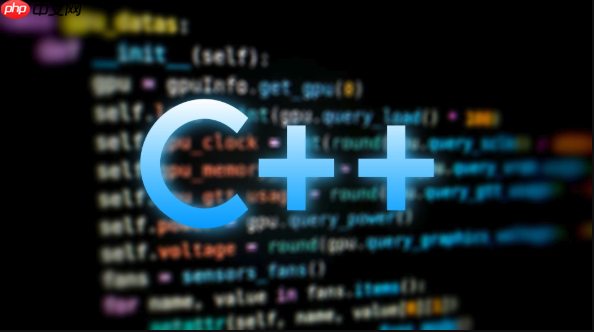C++异常捕获遵循从具体到泛化的匹配顺序,catch块必须按派生类到基类的顺序排列,否则派生类异常会被基类处理器提前捕获,导致特化处理逻辑失效;同时应始终使用const引用捕获异常,避免对象切片,确保多态行为正确执行。

C++的异常捕获,骨子里透着一种“先到先得”的原则,但这个“先到”并非随意,它严格遵循从最具体到最泛化的匹配逻辑。简单来说,当程序抛出一个异常时,运行时会自上而下地遍历
catch
catch
理解C++异常捕获的核心在于其匹配机制和多态特性如何交织。一个异常被
throw
try
catch
catch
具体而言,如果一个
catch
catch (BaseException& e)
DerivedException
catch
catch
catch
catch
另一个需要强调的细节是,捕获异常时,通常建议使用引用(
catch (const MyException& e)
catch (MyException e)
立即学习“C++免费学习笔记(深入)”;
catch
说实话,
catch
C++的异常捕获机制就是这样工作的:它会从
try
catch
catch
想象一下这个场景:你定义了一个
NetworkError
ConnectionTimeoutError
AuthenticationError
#include <iostream>
#include <stdexcept>
// 基类异常
class NetworkError : public std::runtime_error {
public:
NetworkError(const std::string& msg) : std::runtime_error(msg) {}
virtual void log_error() const {
std::cerr << "Logged NetworkError: " << what() << std::endl;
}
};
// 派生类异常:连接超时
class ConnectionTimeoutError : public NetworkError {
public:
ConnectionTimeoutError(const std::string& msg) : NetworkError(msg) {}
void log_error() const override {
std::cerr << "Logged ConnectionTimeoutError: " << what() << " (Consider increasing timeout)" << std::endl;
}
};
// 派生类异常:认证失败
class AuthenticationError : public NetworkError {
public:
AuthenticationError(const std::string& msg) : NetworkError(msg) {}
void log_error() const override {
std::cerr << "Logged AuthenticationError: " << what() << " (Check credentials)" << std::endl;
}
};
void simulate_network_call(int type) {
if (type == 1) {
throw ConnectionTimeoutError("Connection timed out after 10s.");
} else if (type == 2) {
throw AuthenticationError("Invalid username or password.");
} else if (type == 3) {
throw NetworkError("Generic network issue occurred.");
} else {
throw std::runtime_error("Unknown error.");
}
}
int main() {
// 错误顺序的捕获
std::cout << "--- 错误顺序示例 ---" << std::endl;
try {
simulate_network_call(1); // 抛出 ConnectionTimeoutError
} catch (const NetworkError& e) { // 基类捕获块在前面
std::cerr << "Caught by generic NetworkError handler: ";
e.log_error(); // 这里调用的是 NetworkError::log_error(),因为静态类型是 NetworkError
} catch (const ConnectionTimeoutError& e) { // 永不会被执行到
std::cerr << "Caught by specific ConnectionTimeoutError handler: ";
e.log_error();
} catch (const std::exception& e) {
std::cerr << "Caught by std::exception: " << e.what() << std::endl;
}
std::cout << "\n--- 正确顺序示例 ---" << std::endl;
try {
simulate_network_call(1); // 抛出 ConnectionTimeoutError
} catch (const ConnectionTimeoutError& e) { // 特化捕获块在前面
std::cerr << "Caught by specific ConnectionTimeoutError handler: ";
e.log_error(); // 这里调用的是 ConnectionTimeoutError::log_error()
} catch (const AuthenticationError& e) {
std::cerr << "Caught by specific AuthenticationError handler: ";
e.log_error();
} catch (const NetworkError& e) { // 泛化捕获块在后面
std::cerr << "Caught by generic NetworkError handler: ";
e.log_error();
} catch (const std::exception& e) {
std::cerr << "Caught by std::exception: " << e.what() << std::endl;
}
return 0;
}在“错误顺序示例”中,当
ConnectionTimeoutError
catch (const NetworkError& e)
ConnectionTimeoutError
NetworkError
catch
ConnectionTimeoutError
反之,“正确顺序示例”则遵循了从特化到泛化的原则。
ConnectionTimeoutError
catch (const ConnectionTimeoutError& e)
catch
多态性在C++异常处理中扮演的角色,我个人觉得,是其强大和灵活性的一个核心体现。它允许我们构建一个异常的层次结构,就像我们设计普通类那样。这意味着我们可以有一个通用的
BaseException
DerivedException
DerivedException
catch (const DerivedException& e)
catch (const BaseException& e)
这背后的机制其实和普通的多态函数调用有些类似。当一个异常被
throw
catch
catch
catch
BaseException
DerivedException
关键点在于捕获方式:
按引用捕获 (catch (const BaseException& e)
DerivedException
catch (const BaseException& e)
e
const BaseException&
DerivedException
e.log_error()
log_error
按值捕获 (catch (BaseException e)
DerivedException
catch (BaseException e)
DerivedException
BaseException e
DerivedException
BaseException
#include <iostream>
#include <stdexcept>
// 基类异常
class BaseError : public std::runtime_error {
public:
BaseError(const std::string& msg) : std::runtime_error(msg) {}
virtual void print_details() const {
std::cerr << "Base Error: " << what() << std::endl;
}
};
// 派生类异常
class SpecificError : public BaseError {
public:
SpecificError(const std::string& msg, int code) : BaseError(msg), error_code_(code) {}
void print_details() const override {
std::cerr << "Specific Error: " << what() << ", Code: " << error_code_ << std::endl;
}
private:
int error_code_;
};
void throw_specific_error() {
throw SpecificError("Something went wrong specifically.", 101);
}
int main() {
std::cout << "--- 捕获派生类异常作为基类引用 ---" << std::endl;
try {
throw_specific_error();
} catch (const BaseError& e) { // 捕获基类引用
std::cerr << "Caught by BaseError reference: ";
e.print_details(); // 调用 SpecificError 的 print_details()
}
std::cout << "\n--- 捕获派生类异常作为基类值 (Slicing) ---" << std::endl;
try {
throw_specific_error();
} catch (BaseError e) { // 捕获基类值,发生切片
std::cerr << "Caught by BaseError value (slicing): ";
e.print_details(); // 仅调用 BaseError 的 print_details()
}
return 0;
}通过这个例子,我们清楚地看到,按引用捕获时,即使
catch
在我看来,设计异常类层次结构,就像是在为程序的各种错误情境构建一个分类体系。一个好的体系能让你高效地识别和处理问题,而一个糟糕的设计则可能让你在错误面前手足无措。这里面确实有不少坑,也有一些我个人觉得很实用的最佳实践。
常见陷阱:
对象切片 (Object Slicing) 的忽视: 这是最常见的陷阱,上面也提到了。如果你
catch (MyBaseException e)
catch (const MyBaseException& e)
MyDerivedException
MyDerivedException
const
catch (...)
catch (...)
抛出指针而不是对象: 有些人可能会
throw new MyException("error message");delete
catch
delete
throw MyException("error message");异常层次结构过于扁平或过于复杂:
std::exception
异常信息不足: 一个异常如果只告诉你“出错了”,那它几乎是没用的。好的异常应该包含足够的信息,比如错误消息、错误码、触发异常的文件名和行号、甚至相关的上下文数据。
推荐的最佳实践:
构建有意义的异常层次结构: 像
std::exception
ApplicationError
FileError
FileNotFoundError
FilePermissionError
NetworkError
ConnectionError
TimeoutError
LogicError
InvalidArgumentError
InvalidStateError
总是通过const
catch (const MyException& e)
const
catch
异常类继承自std::exception
std::exception
catch (const std::exception& e)
what()
提供丰富且有用的异常信息: 确保你的异常类构造函数能够接受并存储足够的信息,以便在捕获时能够进行有效的诊断。重写
what()
class MyCustomError : public std::runtime_error {
public:
MyCustomError(const std::string& msg, int code = 0, const std::string& context = "")
: std::runtime_error(msg), error_code_(code), context_info_(context) {}
const char* what() const noexcept override {
// 可以在这里组合更详细的信息
// 实际应用中可能需要更复杂的字符串构建
return std::runtime_error::what();
}
int get_error_code() const { return error_code_; }
const std::string& get_context_info() const { return context_info_; }
private:
int error_code_;
std::string context_info_;
};利用RAII实现异常安全: 资源获取即初始化(RAII)是C++中实现异常安全代码的基石。确保所有资源(内存、文件句柄、锁等)都通过对象进行管理,这些对象在其构造函数中获取资源,并在析构函数中释放资源。这样,即使在异常抛出时,资源也能被正确清理。
noexcept
noexcept
noexcept
std::terminate
避免在异常析构函数中抛出异常: 这是一个非常危险的行为。如果一个异常在栈展开过程中被抛出,而此时某个析构函数又抛出了另一个异常,程序会立即终止。析构函数应该总是
noexcept
总而言之,异常处理的设计是一个系统工程,它需要你对程序的错误模式有深入的理解。遵循这些原则,可以帮助你构建一个健壮、可维护且易于调试的C++应用程序。
以上就是C++异常捕获顺序与多态解析的详细内容,更多请关注php中文网其它相关文章!

每个人都需要一台速度更快、更稳定的 PC。随着时间的推移,垃圾文件、旧注册表数据和不必要的后台进程会占用资源并降低性能。幸运的是,许多工具可以让 Windows 保持平稳运行。




Copyright 2014-2025 https://www.php.cn/ All Rights Reserved | php.cn | 湘ICP备2023035733号